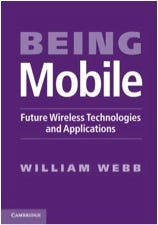Many-layered things
In the second instalment of the serialisation of his book Being Mobile on Telecoms.com, Ofcom’s William Webb investigates the complexities of network architecture and looks at different suggestions for improvement.
November 1, 2010

By William Webb
In the second instalment of the serialisation of his book Being Mobile on Telecoms.com, Ofcom’s William Webb investigates the complexities of network architecture and looks at different suggestions for improvement.
There is a key trade-off in the design of wireless networks. Lower frequencies are generally preferred for their better propagation, making coverage simpler and cheaper. But at lower frequencies there is less spectrum available, with the result that networks tend to have a lower capacity. This is a basic law of physics and not something that can be changed in the future with technological advances (although the capacity per unit spectrum does tend to improve over time).
This trade-off means that there is rarely one perfect system. Instead, lower frequency systems are used to provide coverage across large areas but with relatively low capacity, while high frequency systems provide much greater capacity in high density areas.
Hence the current hierarchy of wireless systems; where 2G technology at 900MHz provides wide area coverage at data rates of around 100kbits/s, 3G coverage at 2.1GHz covers around 30 per cent of a country (depending on the topography and population distribution) at data rates of around 1Mbits/s and wifi at 2.4GHz or 5GHz covers buildings and very dense urban areas at data rates of around 10Mbits/s. Such a hierarchy has evolved over time as the most economic way to provide a service as close as possible to the user requirements.
Home systems
One natural consequence of hierarchical cell systems is for there to be very high capacity but small cells covering homes (and other buildings). Indeed many homes do now have a wifi base station providing wireless data coverage throughout. But this is less a result of some “masterplan” to deliver a hierarchical network than it is to do with the utility of being able to avoid home wiring to link computers and printers and, more recently, a convenient way to use laptop computers anywhere in the home.
There is still much uncertainty as to how home wireless networks will evolve. It is possible that WiFi will emerge as the most popular solution but other options, such as femtocells, UWB, distributed 60GHz systems and more, might sit alongside or replace wifi
One key fork in the road is whether voice in the home will continue to be delivered over dedicated home wireless telephones (using DECT), via the mobile device connecting to wifi or via the mobile device connecting to a femtocell providing cellular coverage.
At present, most homes have a dedicated wireless system but this is less convenient than making use of the mobile. Having a dedicated phone also allows access to cheaper call tariffs, although this could also be offered on mobile phones when in the “home zone”. It provides a means of communication when the mobile phone has a flat battery and is a concept very familiar to most families. So it is far from certain that dedicated home wireless systems will be rapidly replaced with solutions that allow the mobile phone to be used. But, over time, it seems likely that changes in tariffs and culture will make use of the mobile more attractive.
The debate over the relative merits of WiFi and femtocells has been taking place for some time, meanwhile, with no clear resolution in sight. Looked at from afar, it makes little difference which technical standard is adopted as long as there is a wireless node in the home, connected to its own backhaul (the home broadband connection).
Any standard will likely provide sufficient connectivity and capacity and the debate revolves around more practical issues. WiFi is in many homes already, while cellular (eg 3G) is in most cellular handsets. Either the home needs to gain a 3G femtocell or handsets need to gain WiFi functionality. Both are eminently possible and both have advantages and disadvantages.
There does not need to be a single “winner”—it is quite possible and likely that there will be multiple wireless systems within the home (indeed there already are with WiFi and DECT cordless systems covering many homes). But as one system becomes more established such that many peripherals and home devices are manufactured with that standard embedded, then it becomes progressively harder for other solutions to gain traction
The deployment of a hierarchical cell network leads to the obvious implication that users should generally be connected to the smallest cell available to them in their location, with the transition between cells of the same size and layers of cells handled automatically as they move. Connecting to the smallest cell enables the highest data rates and most efficient use of resources. However, there may be some occasions, such as when moving rapidly, when connecting to the smallest cell is inappropriate because of the very frequent handovers that would be needed.
The concept of being automatically connected to the fastest and cheapest resource is sometimes known as “always best connected”. While obvious, it is rarely fully enabled in practice. Mostly this is because networks at different points in the hierarchy are owned by different organisations. Cellular operators own the large cells and microcells but individuals or organisations whose main business is not wireless typically own the WiFi hotspots. Meanwhile individuals own home wireless devices which they connect to fixed networks for their backhaul. While there have been many attempts to provide connectivity across all these environments the results have been mixed, due to the misalignment of commercial interests of the communications providers involved.
It is the difference in the commercial alignment or the communications providers and the communications needs of users that is currently preventing many obvious improvements in current communications systems. It is often not in the interest of the cellular provider for their user to use their home wifi network for voice communications from their cellular phone, despite this often being what the user would like to do. The net result is that the user is not always best connected and many new services are not provided, or are offered in sub-optimal ways.

BeingMobile
A community networkThere has long been interest in the idea of users getting together and pooling their resources to build a network they can all share. This has a utopian feel to it that pleases some of the pioneers in the internet and those that feel that large operators do not meet their needs. Many different variants have been proposed, but the basic concept is that each user installs a wireless network in or around their home at their own cost. They then allow others to use their network when near their home as long as reciprocal agreements exist. The hope is that, if everyone in a community joined such a shared network, then there would be good wireless coverage throughout the community without the need for anyone to pay any fees (other than those they already paid for their broadband connection).
Interest in community networks peaked in the early 2000’s as a number of players, particularly in the US, promised to build metropolitan wifi networks covering entire downtown areas. But within just a few years it had become clear to all players that this was not a commercially viable proposition and most networks have now either shut down or have been taken over by the local authorities to be used for emergency services, meter reading and other municipal functions.
With the failure of metro-wifi, interest in community networks has grown again. A number of hot spot providers offer home subscribers the chance to join their network by sharing their resources in return for the ability to access other hot spots in the network.
Just how useful these kinds of networks are is not clear. In a small village or town the benefits of wifi access outside the homes of a few others is probably low. In cities the benefits may grow as the chance of being outside a connected home may be higher and the likelihood of being away from home but wanting a wifi connection may be greater. Alternatively, where there is a strong community which can work together to get many homes signed up simultaneously there may be benefits from the high level of coverage this brings, but this is no substitute for cellular coverage.
Community networks do not change the overall architectural picture; they just make it easier for users to connect to small cells but spreading the deployment effort over a large number of individuals rather than a small number of operators.
Consumers tend to ultimately get what they want. While corporate interests may deliver something different for some time, in a competitive market eventually a disruptive player finds some mechanism to change the value chain. For example, Apple have demonstrated how they are able to change the rules of the cellular industry (although not in a manner that fully realises the always best connected concept) and others can be expected to have a similar effect over time. In some cases, even the cellular operators themselves might change if they perceive that their current business model is not delivering the returns that they require (and this is starting to happen already).
A value chain better aligned with the interests of the user would be one where one or more layers of the hierarchical network were owned by wholesale providers. These organisations would maintain the networks as “bit pipes”, providing data transmission services at a wholesale level to a range of new service providers. The service providers would not own any network resources themselves, but instead would buy a mix of data transmission services from the bit pipe providers and bundle these together into an attractive offering for the end user. Others in the value chain might include application developers who made appropriate applications available through “apps stores”, home network maintainers and so on.
This realignment of the value chain is critical for the future of wireless communications. Without it, inefficient technical solutions will be employed, significantly hampering what can be achieved. When and how it will happen is unclear as it depends on the actions of key individuals running the major players.
An abridged extract from “Being Mobile” by William Webb, Cambridge University Press 2010
You May Also Like






.png?width=300&auto=webp&quality=80&disable=upscale)


_1.jpg?width=300&auto=webp&quality=80&disable=upscale)


.png?width=800&auto=webp&quality=80&disable=upscale)